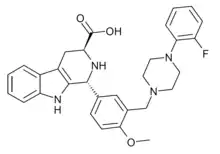 | |
| Identifiers | |
|---|---|
| |
| CAS Number | |
| PubChem CID | |
| ChemSpider | |
| ChEBI | |
| ChEMBL | |
| Chemical and physical data | |
| Formula | C30H31FN4O3 |
| Molar mass | 514.601 g·mol−1 |
| 3D model (JSmol) | |
| |
| |
Trans-NED-19 is a drug which acts as a potent and selective antagonist of the endogenous calcium channel opener nicotinic acid adenine dinucleotide phosphate (NAADP), thereby reducing the normal NAADP-mediated calcium flux without blocking calcium channels directly. It is used in research into the functions of NAADP signalling inside many different cell types.[1][2][3][4][5][6][7][8]
References
- ↑ Naylor E, Arredouani A, Vasudevan SR, Lewis AM, Parkesh R, Mizote A, et al. (April 2009). "Identification of a chemical probe for NAADP by virtual screening". Nature Chemical Biology. 5 (4): 220–6. doi:10.1038/nchembio.150. PMC 2659327. PMID 19234453.
- ↑ Rosen D, Lewis AM, Mizote A, Thomas JM, Aley PK, Vasudevan SR, et al. (December 2009). "Analogues of the nicotinic acid adenine dinucleotide phosphate (NAADP) antagonist Ned-19 indicate two binding sites on the NAADP receptor". The Journal of Biological Chemistry. 284 (50): 34930–4. doi:10.1074/jbc.M109.016519. PMC 2787355. PMID 19826006.
- ↑ Park KH, Kim BJ, Shawl AI, Han MK, Lee HC, Kim UH (December 2013). "Autocrine/paracrine function of nicotinic acid adenine dinucleotide phosphate (NAADP) for glucose homeostasis in pancreatic β-cells and adipocytes". The Journal of Biological Chemistry. 288 (49): 35548–58. doi:10.1074/jbc.M113.489278. PMC 3853300. PMID 24165120.
- ↑ Lee S, Paudel O, Jiang Y, Yang XR, Sham JS (March 2015). "CD38 mediates angiotensin II-induced intracellular Ca(2+) release in rat pulmonary arterial smooth muscle cells". American Journal of Respiratory Cell and Molecular Biology. 52 (3): 332–41. doi:10.1165/rcmb.2014-0141OC. PMC 4370261. PMID 25078456.
- ↑ Davidson SM, Foote K, Kunuthur S, Gosain R, Tan N, Tyser R, et al. (December 2015). "Inhibition of NAADP signalling on reperfusion protects the heart by preventing lethal calcium oscillations via two-pore channel 1 and opening of the mitochondrial permeability transition pore". Cardiovascular Research. 108 (3): 357–66. doi:10.1093/cvr/cvv226. PMC 4648198. PMID 26395965.
- ↑ Pereira GJ, Antonioli M, Hirata H, Ureshino RP, Nascimento AR, Bincoletto C, et al. (February 2017). "Glutamate induces autophagy via the two-pore channels in neural cells". Oncotarget. 8 (8): 12730–12740. doi:10.18632/oncotarget.14404. PMC 5355049. PMID 28055974.
- ↑ Hermann J, Bender M, Schumacher D, Woo MS, Shaposhnykov A, Rosenkranz SC, et al. (2020). "2+ Homeostasis in Mouse Hippocampal Neurons". Frontiers in Cell and Developmental Biology. 8: 496. doi:10.3389/fcell.2020.00496. PMC 7333232. PMID 32676502.
- ↑ Jin X, Zhang Y, Alharbi A, Hanbashi A, Alhoshani A, Parrington J (August 2020). "Targeting Two-Pore Channels: Current Progress and Future Challenges". Trends in Pharmacological Sciences. 41 (8): 582–594. doi:10.1016/j.tips.2020.06.002. PMC 7365084. PMID 32679067.
This article is issued from Wikipedia. The text is licensed under Creative Commons - Attribution - Sharealike. Additional terms may apply for the media files.